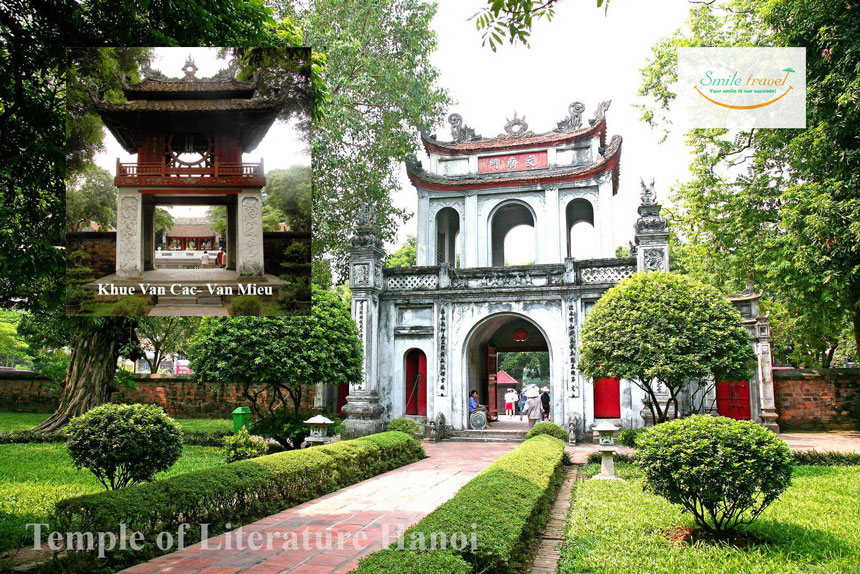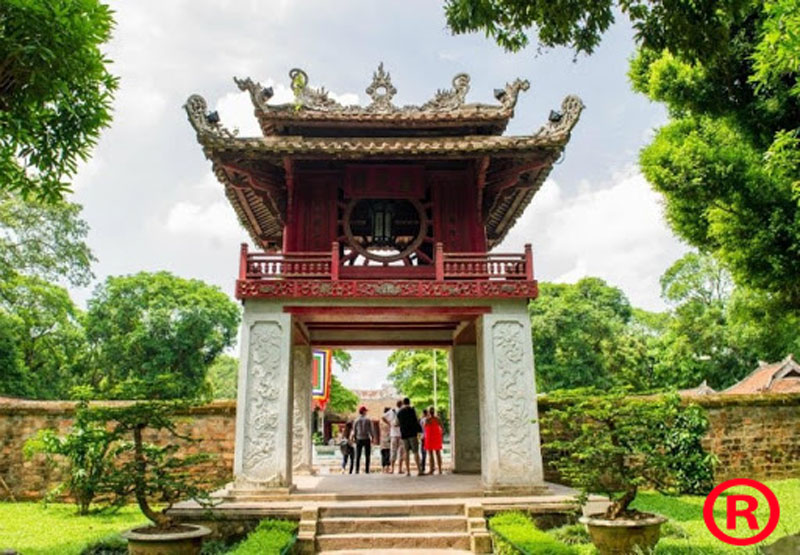
Temple of Literature Entrance Fee 2020 [ New]
TICKET PRICE of Temple of Literature:
– VND 30,000 for adults.
– VND 15,000 for students (with student ID or student ID)
– VND 15,000 for people with serious disabilities, elderly 60 years and up (being Vietnamese citizens, with identity card)
– Free for children under 15 years old
—
NECESSARY INFORMATION ABOUT OPENING TIMES AND SIGHTSEEING
In the summer, Temple of Literature – Quoc Tu Giam is open weekdays from 7:30 am to 17:30 pm.
In the winter, the Temple of Literature – Quoc Tu Giam is open weekdays from 8:00 am to 17:30 pm.
Please visit the ticket and present the ticket at the ticket counter
Please follow the rules when visiting.
We wish you a useful and interesting tour!
—
PRACTICAL INFOMATION
Opening
Summer: 07:30 – 17:30
Winter: 08:00 – 17:30
Address: 58 Quoc Tu Giam, Dong Da, Ha Noi
Contact phone number
+84 438 452 917
+84 438 235 601
Fax: +84 437 472 566
Email: tthdvhkhvmqtg_sovhtt@hanoi.gov.vn

Van Mieu – Quoc Tu Giam
Brief:
Temple of Literature (Van Mieu-Quoc Tu Giam) which was founded in the late 11th Century, is situated to the south of the Thang Long Imperial Citadel. This complex includes Van Mieu and Quoc Tu Giam. Van Mieu was constructed in 1070 under Ly Thanh Tong’s reign. In 1076, by the order of King Ly Nhan Tong, Quoc Tu Giam was founded behind Van Mieu. Through ups and downs in Vietnamese history, today the relic that is nearly 1.000 years old has had its architectural features of the Le and Nguyen Dynasty preserved in a good condition.
The complex covers an area of 54.331 square meters, including the Interior and Exterior Area. The Exterior Area includes Van lake and Giam garden. The Interior Area is divided into five sections, each of which is surrounded by a brick wall. Each of the sections has three gates, a bigger one in the center and two smaller ones to the sides. The five sections include Nhập Đạo courtyard, Thành Đạt courtyard (Great Success), Garden of Doctor Steles, Đại Thành courtyard and Thái Học courtyard
Văn Mieu-Quoc Tu Giam, which was founded in the late 11th Century, is situated to the south of the Thang Long Imperial Citadel. This complex includes Van Mieu and Quoc Tu Giam. Van Mieu was constructed in 1070 under Ly Thanh Tong’s reign. In 1076, by the order of King Ly Nhan Tong, Quoc Tu Giam was founded behind Van Mieu. Through ups and downs in Vietnamese history, today the relic that is nearly 1.000 years old has had its architectural features of the Le and Nguyen Dynasty preserved in a good condition.
The complex covers an area of 54.331 square meters, including the Interior and Exterior Area. The Exterior Area includes Van lake and Giam garden. The Interior Area is divided into five sections, each of which is surrounded by a brick wall. Each of the sections has three gates, a bigger one in the center and two smaller ones to the sides. The five sections include Nhập Đạo courtyard, Thành Đạt courtyard (Great Success), Garden of Doctor Steles, Đại Thành courtyard and Thái Học courtyard.
History:
VAN MIEU – QUOC TU GIAM UNDER LY, TRAN, HO DYNASTIES
The Temple of Literature was established under the reign of Ly Thanh Tong, the second year of the Dog, the year of the second year of the Spirit (1070), a place of worship of Confucius, Chu Cong and Tu Phe (the four excellent students of Confucius were Nhan Tu, Tang Tu and Tu Tu and Mencius), and the Seven Sage Sages (72 typical Confucian houses were honored as the Sage), and also the place where Prince Crown Prince Ly Can Duc went to study. Quoc Tu Giam was founded under Ly Nhan Tong, the first year of the first Vu Anh Chieu Thang (1076) was the place for literate officials and children of the Royal Family, the Great Prince in the Capital to study. When newly established, the size of the Temple of Literature – Quoc Tu Giam was still modest, but following the development of Confucian status in society, the Temple of Literature – Quoc Tu Giam was gradually paid attention to and expanded. In the Tran dynasty, although Buddhism was still thriving, although it was very disturbed by the resistance wars against the Nguyen Mong army, the Tran kings were still interested in the Temple of Literature – Quoc Tu Giam and Confucian education. In 1236, the royal court took Pham Ung Than to hold the position of Thuong Thuong and De Quoc Tu Vien to oversee the study at the National Academy. The court allowed the restoration of Quoc Tu institute in 1243 and took a photo of the statue of Chu Cong, Confucius and Manh Tu in 1253 to worship and let the Confucian scholars come to Quoc Tu institute to teach the Four Books and the Six Sutras. The establishment of the National Academy (Giam (school) was changed into an institute) as a learning place for literate officials in the localities and the king’s children, the high official in the imperial capital marking the maturity as well as the big role. Great Temple of Literature – Quoc Tu Giam in this period. The Temple of Literature under the Tran dynasty has been beautifully renovated
VAN MIEU – QUOC TU GIAM UNDER LE SO – MAC DYNASTIES
The Temple of Literature was established under the reign of Ly Thanh Tong, the second year of the Dog, the year of the second year of the Spirit (1070), a place of worship of Confucius, Chu Cong and Tu Phe (the four excellent students of Confucius were Nhan Tu, Tang Tu and Tu Tu and Mencius), and the Seven Sage Sages (72 typical Confucian houses were honored as the Sage), and also the place where Prince Crown Prince Ly Can Duc went to study. Quoc Tu Giam was founded under Ly Nhan Tong, the first year of the first Vu Anh Chieu Thang (1076) was the place for literate officials and children of the Royal Family, the Great Prince in the Capital to study. When newly established, the size of the Temple of Literature – Quoc Tu Giam was still modest, but following the development of Confucian status in society, the Temple of Literature – Quoc Tu Giam was gradually paid attention to and expanded. In the Tran dynasty, although Buddhism was still thriving, although it was very disturbed by the resistance wars against the Nguyen Mong army, the Tran kings were still interested in the Temple of Literature – Quoc Tu Giam and Confucian education. In 1236, the royal court took Pham Ung Than to hold the position of Thuong Thuong and De Quoc Tu Vien to oversee the study at the National Academy. The court allowed the restoration of Quoc Tu institute in 1243 and took a photo of the statue of Chu Cong, Confucius and Manh Tu in 1253 to worship and let the Confucian scholars come to Quoc Tu institute to teach the Four Books and the Six Sutras. The establishment of the National Academy (Giam (school) was changed into an institute) as a learning place for literate officials in the localities and the king’s children, the high official in the imperial capital marking the maturity as well as the big role. Great Temple of Literature – Quoc Tu Giam in this period. The Temple of Literature under the Tran dynasty has been beautifully renovated
VAN MIEU – QUOC TU GIAM DURING THE PERIOD 1802-1945
Under the Nguyen dynasty, Thang Long was not considered as the capital, but it became the center of the Hoai Duc prefecture, later belonged to the Northern Citadel region. During this period, Van Mieu was called Van Mieu Bac Thanh and later changed its name to “Van Mieu Hanoi”. Quoc Tu Giam and became the school of Hoai Duc prefecture and developed into the Khai Thanh Shrine dedicated to Confucius’ parents.
During this time, Van Mieu Hanoi was dedicated to Confucius and his 4 best disciples in the Great Sanctuary. The East and West wings were for the worship of 72 Confucian sages. The Khai Thanh Shrine was a place for honoring Confucius’ parents. However this vestige no longer had the function of an advanced educational center in the country, but with its special significance, Van Mieu of the Northern Citadel region was paid attention and was restored during the Nguyen dynasty.
In 1805, the Khue Van Cac (constellation pavilion) was constructed by Nguyen Van Thanh, the chief of the Northern Citadel region at Van Mieu. It is such a unique architectural project: it is a wooden square pavilion with double roofs of pipe-shaped tiles; it was erected on a square foundation tiled with Bat Trang bricks. The pavilion was built on 4 square brick pillars. The edges of the pavilion are wooden, its roofs were covered with pipe-shaped tiles and 4 circular windows attached with spikes radiating outward, symbolizing the shining Khue constellation, that “monitors literature” which gives high regard to the Confucian educational center, and this has contributed to increasing the cultural and artistic values of Van Mieu – Quoc Tu Giam.
In 1808, after the construction of Van Mieu in the Capital Hue, the Nguyen dynasty ordered Van Mieu should be indifferent localities with Van Mieu of the Northern Citadel region honoring the tablet of Confucius, but not for worshiping his statue. If any place had statues they had to look for a clean land to bury them. Hence, Van Mieu had only worshipped tablets of Confucius and Confucian sages.
In 1827, under the reign of the King Minh Menh, an order was given to collect printing blocks of Ngu Kinh (Five Classics) and Tu Thu Dai Toan (Complete Four Books) and Vo Kinh Truc Giang in Van Mieu of the Northern Citadel region and bring them to Quoc Tu Giam in the capital of Hue. In 1833, the Great House of Ceremony and the Great Sanctuary was repaired and repainted; the surrounding walls of Van Mieu were rebuilt. In 1858, two pavilions on the right and left housing steles were constructed, with 11 rooms each. In 1863, Hoang Giap (official doctoral laureate), treasurer of Hanoi Le Huu Thanh and An sat (the title of feudal provincial civil mandarins in charge of criminal cases) Dang Ta raised fund to rebuild 4 pavilions, two on each side, with 11 rooms each for the protection of the doctoral laureates’ steles.
After the Patenôtre Treaty (1888), the French completely ruled Hanoi. During the period 1888-1945, Van Mieu – Quoc Tu Giam had the most changes in its history. Van Mieu was turned into a French military area, then a dispensary to isolate patients affected by cholera in Hanoi. Specifically, the French protectorate used a large part of the area in the North of this site for the planning of streets. Due to the enduring struggle of the people of Hanoi to protect this vestige from the French invasion, the French military decided to return this vestige for the local authorities to control; thus offering ceremonies were restored in Van Mieu – Quoc Tu Giam.
During the period 1888-1945, Van Mieu was under restoration for different periods in 1888, 1897-1901, and in 1904-1909. The last biggest restoration of Van Mieu in 1888 was recorded on the wooden board with the Chinese characters “Dai Thanh Gate” (Great Synthetic Gate) and on the horizontal board with the Chinese characters: “Van The Su Bieu” (the everlasting exemplary educator). Moreover, to comfort Vietnamese, the Minister plenipotentiary of the Northern region provided finance for the repairing of worshipping rooms, the buying of ceremonial tools and asked for the yields collected from the surrounding land with an area of over 12.300 m2 for the management and restoration of Van Mieu. In 1906, Van Mieu – Quoc Tu Giam was ranked as a historical and cultural vestige by the General Governor to Indochina.
Van Mieu – Quoc Tu Giam under the Nguyen dynasty (1802-1945) had to overcome many ups and downs; however, this vestige was always preserved, maintained and well deserved as the quintessential educational and cultural center of the nation.
VAN MIEU – QUOC TU GIAM IN THE PERIOD 1945-1988
After 1945, Van Mieu – Quoc Tu Giam was the principal worshipping place, so the only activities held at Van Mieu were offering ceremonies to Confucius and Confucian scholars. It is noted that President Ho Chi Minh went there to conduct the Autumn offering ceremony on 21st October 1945 and the Minister of the Interior of the Democratic Republic of Vietnam, Huynh Thuc Khang organized the Autumn offering ceremony on 22nd September 1946. These events affirmed the significance of the role and great value of Van Mieu – Quoc Tu Giam for the national culture in a new historical situation.
After September 1946, the organization of offering ceremonies was held according to the national democracy and progressiveness of the government of the Democratic Republic of Vietnam. An offering ceremony was organized once a year on the date of Confucius’ birth (27 August). The rules and modes of the conduct of the ceremony were simple. Instead of lying prostrate, the participants of the ceremony needed to kneel down and they could wear western costumes. The offerings were also simple, practical, mainly flowers and fruit.
During the war of French resistance (1946-1954), Van Mieu – Quoc Tu Giam was almost destroyed. At the beginning of the national war of colonial resistance (1946-1947), the Khai Thanh Shrine and East and West wings in the Great Sanctuary Section were damaged.
To protect the vestige of Van Mieu – Quoc Tu Giam, some people who had responsibility for the national culture, founded “Van Mieu học Hiệp hội (Van Mieu study Association) with the purpose of the restoration and maintenance of the vestige. “Van Mieu study Association” made a great contribution to the preservation of the vestige until the day of liberation for Hanoi (1954).
In 1954, after taking over the Capital, the Culture branch in Hanoi authorized the restoration of Van Mieu. The Left and Right wings in the Dai Thanh courtyard were then restored.
On April 28, 1962, Van Mieu – Quoc Tu Giam was ranked as a National Historical and Cultural Vestige by the Ministry of Culture of Vietnam.
On April 25, 1988, the Center for Cultural and Scientific Activities Van Mieu – Quoc Tu Giam was founded, its office is located inside the vestige; it assumes the task of preservation, restoration, management and exploitation of the vestige and brings into play the values of Van Mieu – Quoc Tu Giam of building modern Vietnamese culture.
Smile Travel is one of the fast growing Tour Companies in Vietnam. We are as Inbound and Outbound Tour Operator Licence No 01-1051/TCDL-GPLHQT. We specialize in tailor-making and customizing individual, Couple, family and group tours throughout Indochina destinations.
Our Tour:
Halong Cruises Tours, Vietnam Classic Tours, Hanoi Daily Tours, Danang Daily Tours, Ho Chi Minh Daily Tours, Biking and Motorbike Tours,Vietnam Beach/ Relaxing Tours,Vietnam Muslim tour in Hanoi,Vietnam Muslim tour in Danang ,Vietnam Muslim tour in Ho Chi Minh,Vietnam Eco Tours,Vietnam- Laos Tours,Vietnam- Cambodia Tours,Vietnam- Myanmar Tours,
Our Travel Services:
Tour Guide, Car/Motorbike For Rent, Visa to Vietnam, Bus Tickets, Bus Tickets, Flight Tickets, Train Tickets
--------------------------------------------------
